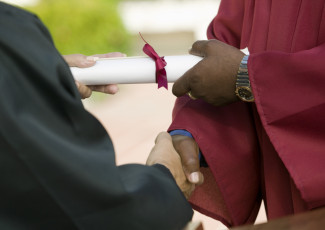Reverse Transfer: A Problem of Tracking
By Bob Woods
April 7, 2014
Transfer programs that retroactively give former community college students credit for education completed at a four-year college are increasingly popular, but tracking students through the process is a challenge.
In 2012, Michigan passed an education funding bill that required the state’s 15 public universities to participate in reverse-transfer programs with at least three of the state’s community colleges by January 2013. The legislation was widely hailed as well intentioned: As the focus on campuses shifted from access to success, transfer students needed a way to effectively link credits from prior educational experiences.
But as administrators soon found out, keeping track of all those credits, and when and where they were earned, is easier said than done.
“With a decentralized system of 28 community colleges, each operating independently, the tracking issue becomes an interesting one,” explains Chris Baldwin, executive director of the Michigan Center for Student Success (MCSS), an initiative of the Michigan Community College Association. Baldwin’s comments shed light on a common frustration with modern reverse-transfer programs: With so many disparate systems at play, there is often no reliable breadcrumb trail — digital or otherwise — with which to verify that transfer students have completed the work to earn an associate degree.
The reality is bad for students, many of whom would welcome every potential advantage in a competitive job market. The reality is bad for colleges as well: Students who transfer without first earning a degree often count against an institution’s completion rate.
In an ideal world, a good reverse-transfer program would eliminate these failings.
How it works
By mutual agreement, the university retroactively sends a copy of the transfer-student’s transcript to the community college. The community college then combines that data with the student’s previous academic results, verifies that all the credits add up, and notifies the student that he or she has earned an associate degree.

When done right, reverse transfer represents a win-win for colleges and students. Yet, as Michigan and other states have discovered along the way, the process is often fraught with inefficiencies, which could prevent students and colleges from taking credit for their accomplishments.
It all comes down to a single word: tracking. Tracking systems enable participating colleges to identify eligible students, regularly update course work and credits to ensure learners stay on track, share and verify data with partner institutions, award degrees when relevant and document completion rates. The best systems are fully automated and sync up with other forms of data analytics and software.
A common approach
In Michigan, it is estimated that 79 percent of community college students transfer to public universities without first earning an associate degree.
“We want to get to a common approach, but that hasn’t happened yet,” Baldwin says. “There’s a lot of work that needs to be done, such as honing eligibility requirements, processes for reaching out to students, procedural requirements for degrees, and the impediments for awarding them.”
In 2012, MCSS received a $500,000 grant from the Kresge Foundation to fund the reverse-transfer program, which would focus on coordinating a statewide tracking system. The goal: to award 2,400 associate degrees through reverse transfer over the two-year life of the grant.
The grant is one of several provided as part of an ambitious, $6.4 million campaign among five prestigious national foundations to spur adoption of reverse transfer programs. In addition to Kresge, USA Funds, the Bill & Melinda Gates Foundation, the Helios Education Foundation and the Lumina Foundation have contributed to “Credit When It’s Due: Recognizing the Value of the Quality Associate Degree.” So far, the program has doled out grants to reverse-transfer programs in 12 states.
In January, Tennessee unveiled a statewide reverse-transfer program.
It’s estimated that of the 2,300 students who transfer each year from one of Tennessee’s 13 community colleges with 45 to 60 credits, as many as 1,300 would be eligible for an associate degree.
The program, which includes the collaboration of numerous statewide education agencies, including the University of Tennessee system, the Tennessee Board of Regents, the Tennessee Independent Colleges and Universities Association and the Tennessee Higher Education Commission, is underwritten by a $400,000 grant from the Lumina Foundation. Officials say that the money will go toward developing software to track students through different parts of the system. It won’t be easy.
“The system has to be automated and accommodate the quirks of all the different schools,” explains Ellen Weed, the former vice president of academic affairs at Nashville State Community College, who now works part time for the college and for the Tennessee Board of Regents. “It’s a logistical challenge, but this could impact a great number of students.”
It’s a logistical challenge, but this could impact a great number of students.
“We’re working with a software vendor to set up a system whereby twice a year, in January and July, the institutions will each be directed to particular student queries by the main software,” explains India Lane, University of Tennessee’s assistant vice president for academic affairs and student success. The extract will identify community college students who have transferred to the university with at least 15 credits (60 credit hours). The system will then compare the results with 49 different degree pathways linked from participating community colleges to determine whether the student is eligible for a degree.
“Essentially, once that first extract occurs, and continual extracts occur, the Higher Education Commission, as well as some institutions, will be following that cohort of students as it grows and see what happens to them,” Lane says.
Working model
While Tennessee is just ramping up reverse-transfer programs, El Paso Community College (EPCC), in Texas, has been running a promising program of its own since 2006.
EPCC and the University of Texas at El Paso (UTEP) are the only higher education providers in the immediate area and have a history of mutual dependency. Eighty percent of UTEP undergraduates have also taken courses at EPCC at any given time, according to Donna Ekal, associate provost for undergraduate studies at UTEP.
“In 2005, the question came up as to why our graduation rates were not higher, why we weren’t awarding more associate degrees,” recalls Daryle Hendry, executive director of admissions at EPCC.
Despite regular sharing of student data between the colleges, EPCC did not receive student transcripts from UTEP to articulate lower-division credit until students were ready to graduate. By then, it’s often too late.

Hendry and his counterparts at UTEP started exchanging student data earlier, taking a close look at recent transfer students who left EPCC without earning an associate degree but who completed their core curriculum at the university.
“If they met the requirement for an associate degree,” Hendry says, “we notified the students and awarded them degrees. That’s reverse transfer.”
How the colleges tracked students is instructive. From that first data swap, more than 6,000 student transcripts were analyzed. “The process wasn’t automated,” Hendry explains, “so one by one, by hand, we articulated the credits and did degree audits on each student.”
In May 2006, EPCC awarded 375 associate degrees. It marked the beginning of what’s now known as the EPCC-UTEP Transfer Program.
That year, the transfer program awarded an incredible 1,166 reverse-transfer degrees.
In 2010, the program launched its first automated review system, replacing the analog method. That year, the transfer program awarded an incredible 1,166 reverse-transfer degrees. Officials said the large number accounted for all the students who were missed during four years of imprecise manual tracking. By 2011, the number of reverse-transfer degrees was back down to 317.
“Now, I run a report at the end of every semester that can give me a list of all the students who have 15 or more credit hours from EPCC and who have completed the requirements for the associate degree that I’ve put into our system,” Ekal explains. “We run the list, I send it to Daryle at EPCC, he confirms everything, and EPCC awards their degrees. It’s a beautiful system.”
How does your college approach reverse-transfer tracking?










